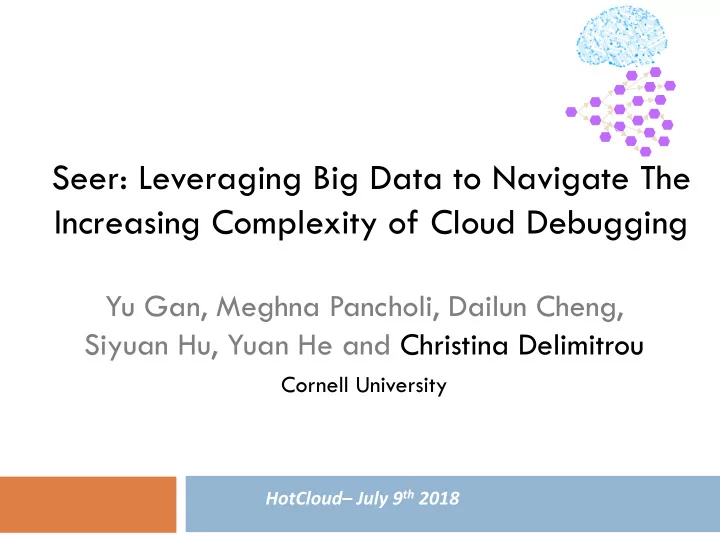

Seer: Leveraging Big Data to Navigate The Increasing Complexity of Cloud Debugging Yu Gan, Meghna Pancholi, Dailun Cheng, Siyuan Hu, Yuan He and Christina Delimitrou Cornell University HotCloud– July 9 th 2018
Executive Summary ¨ Microservices puts more pressure on performance predictability ¤ Microservices dependencies à propagate & amplify QoS violations ¤ Finding the culprit of a QoS violation is difficult ¤ Post-QoS violation, returning to nominal operation is hard ¨ Anticipating QoS violations & identifying culprits ¨ Seer: Data-driven Performance Debugging for Microservices ¤ Combines lightweight RPC-level distributed tracing with hardware monitoring ¤ Leverages scalable deep learning to signal QoS violations with enough slack to apply corrective action 2
From Monoliths to Microservices 3
Motivation ¨ Advantages of microservices: ¤ Ease & speed of code development & deployment ¤ Security, error isolation ¤ PL/framework heterogeneity ¨ Challenges of microservices: ¤ Change server design assumptions ¤ Complicate resource management à dependencies ¤ Amplify tail-at-scale effects ¤ More sensitive to performance unpredictability ¤ No representative end-to-end apps with microservices 4
An End-to-End Suite for Cloud & IoT Microservices ¨ 4 end-to-end applications using popular open-source microservices à ~30-40 microservices per app ¤ Social Network ¤ Movie Reviewing/Renting/Streaming ¤ E-commerce ¤ Drone control service ¨ Programming languages and frameworks: ¤ node.js, Python, C/C++, Java/Javascript, Scala, PHP , and Go ¤ Nginx, memcached, MongoDB, CockroachDB, Mahout, Xapian ¤ Apache Thrift RPC, RESTful APIs ¤ Docker containers ¤ Lightweight RPC-level distributed tracing 5
Resource Management Implications Netflix Twitter Movie Streaming Amazon ¨ Challenges of microservices: ¤ Dependencies complicate resource management ¤ Dependencies change over time à difficult for users to express ¤ Amplify tail@scale effects 6
The Need for Proactive Performance Debugging ¨ Detecting QoS violations after they occur: ¤ Unpredictable performance propagates through system ¤ Long time until return to nominal operation ¤ Does not scale 7
Queue CPU Mem Net Disk Performance Implications 8
Queue CPU Mem Net Disk Performance Implications 9
Seer: Data-Driven Performance Debugging ¨ Leverage the massive amount of traces collected over time Apply online, practical data mining techniques that 1. identify the culprit of an upcoming QoS violation Use per-server hardware monitoring to determine the 2. cause of the QoS violation Take corrective action to prevent the QoS violation from 3. occurring ¨ Need to predict 100s of msec – a few sec in the future 10
Gantt charts microservices Tracing Framework Client http latency ¨ RPC level tracing […] ¨ Based on Apache Thrift WebUI ¨ Timestamp start-end QueryEngine for each microservice TCP TCP proc RX zTracer App proc ¨ Store in centralized DB Proc Cassandra TCP proc TX TCP (Cassandra) uService K RPC time TX ¨ Record all requests à Tracing RPC time RX Collector No sampling TCP ¨ Overhead: <0.1% in zTracer Proc throughput and <0.2% TCP uService K+1 in tail latency […] 11
Deep Learning to the Rescue ¨ Why? ¤ Architecture-agnostic ¤ Adjusts to changes in dependencies over time ¤ High accuracy, good scalability ¤ Inference within the required window 12
DNN Configuration Input Output signal signal Which ¨ Container microservice utilization will cause a QoS violation ¨ Latency in the near future? ¨ Queue depth 13
DNN Configuration Input Output signal signal Which ¨ Container microservice utilization will cause a QoS violation ¨ Latency in the near future? ¨ Queue depth 14
DNN Configuration ¨ Training once: slow (hours - days) ¤ Across load levels, load distributions, request types ¤ Distributed queue traces, annotated with QoS violations ¤ Weight/bias inference with SGD ¤ Retraining in the background ¨ Inference continuously: streaming trace data 93% accuracy in signaling upcoming QoS violations 91% accuracy in attributing QoS violation to correct microservice 15
DNN Configuration Accuracy stable or increasing with cluster size ¨ Challenges: ¤ In large clusters inference too slow to prevent QoS violations ¤ Offload on TPUs, 10-100x improvement; 10ms for 90 th %ile inference ¤ Fast enough for most corrective actions to take effect (net bw partitioning, RAPL, cache partitioning, scale-up/out, etc.) 16
Experimental Setup ¨ 40 dedicated servers ¨ ~1000 single-concerned containers ¨ Machine utilization 80-85% ¨ Inject interference to cause QoS violation ¤ Using microbenchmarks (CPU, cache, memory, network, disk I/O) 17
Restoring QoS ¨ Identify cause of QoS violation ¤ Private cluster: performance counters & utilization monitors ¤ Public cluster: contentious microbenchmarks ¨ Adjust resource allocation ¤ RAPL (fine-grain DVFS) & scale-up for CPU contention ¤ Cache partitioning (CAT) for cache contention ¤ Memory capacity partitioning for memory contention ¤ Network bandwidth partitioning (HTB) for net contention ¤ Storage bandwidth partitioning for I/O contention 18
Restoring QoS ¨ Post-detection, baseline system à dropped requests ¨ Post-detection, Seer à maintain nominal performance 19
Demo Queue CPU Mem Net Disk 20
21
Challenges Ahead Serverless microservices IoT swarms ¨ Security implications of data-driven approaches ¨ Fall-back mechanisms when ML goes wrong ¨ Not a single-layer solution à Predictability needs vertical approaches Thank you! 22
Recommend
More recommend